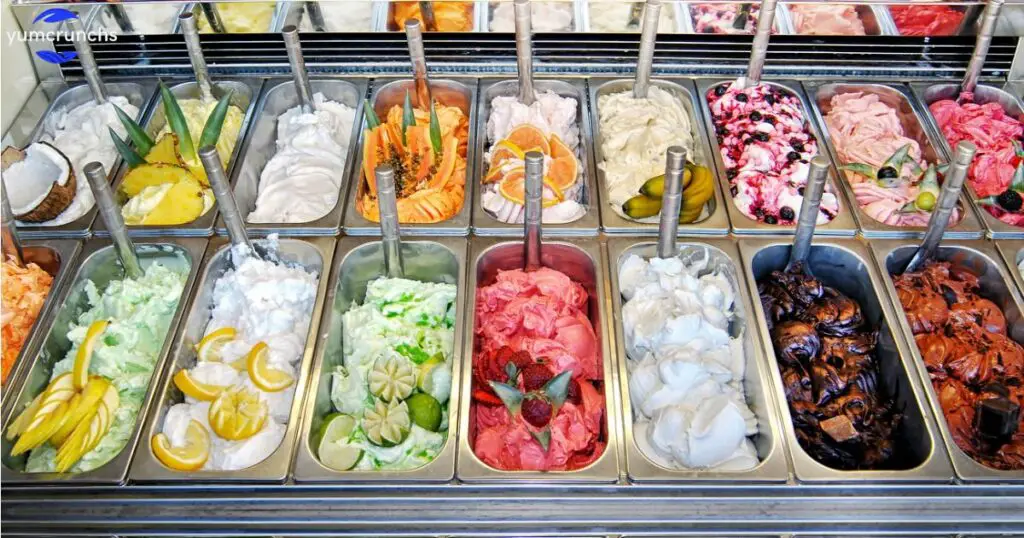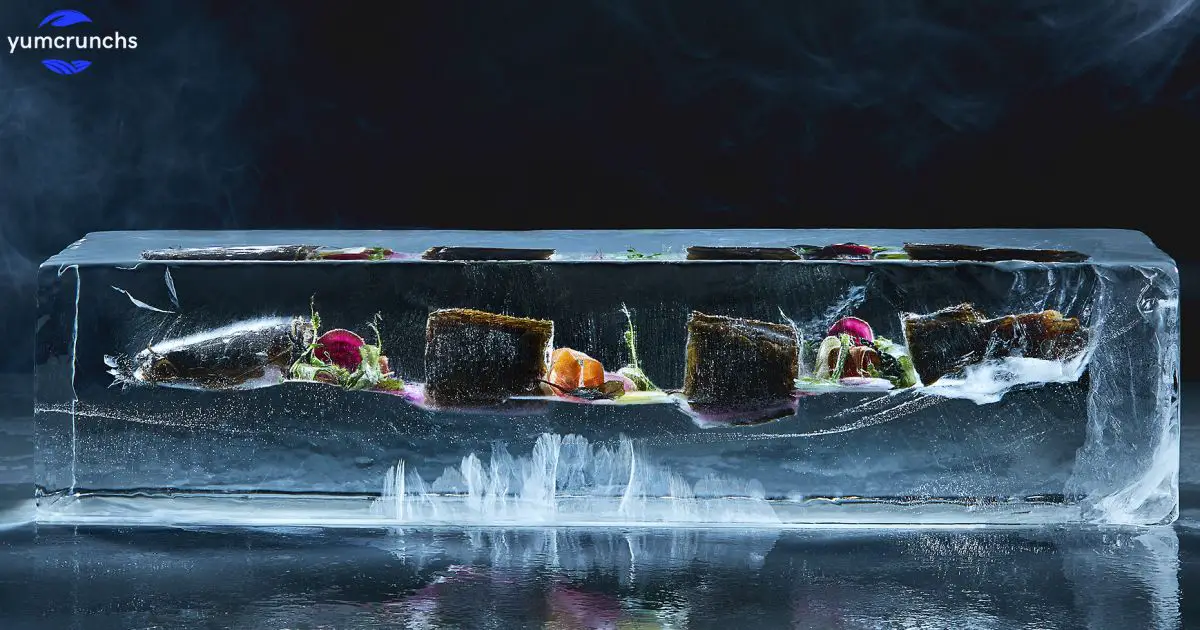When you display food in ice, ensuring its safety and quality becomes paramount. Whether it’s a buffet at a party or a display at a seafood market, proper handling of food surrounded by ice is crucial. In this discussion, we’ll explore the importance of maintaining food safety standards in such settings and highlight key considerations for preserving the freshness of food while on display.
Imagine walking into a festive event with a beautifully arranged array of delicacies nestled in ice. It’s a sight to behold, but have you ever wondered about the meticulous steps required to maintain the freshness and safety of the food in such a setup? How does one ensure that the ice not only enhances the presentation but also serves as a reliable means of preserving the food’s quality? Let’s delve into this intriguing aspect of food presentation and safety.One good way to show off food on ice is by using shallow containers or trays filled with crushed ice or ice packs. This keeps the food cold and lowers the chance of germs spreading between different foods.
Adding layers of ice between the containers helps keep the temperature steady, so things like meat and dairy stay safe to eat.It’s also important to check the ice often to make sure it stays really cold, ideally below 40°F (4°C), to stop bacteria from growing. You should add more ice when it melts and throw away any water that builds up. If you follow these steps, you can make a nice display while making sure the food stays safe to eat. And remember, always keep an eye on the ice!
How do you keep food cold when displayed on ice?
When you’re showing off food in ice, like at a picnic or a fancy party, keeping it cool is key. Ice is like a chilly blanket, wrapping around the food to stop it from getting warm and gross. First, you need a big container to hold all the ice and the food. Then, you put a layer of ice at the bottom, like a frosty carpet. Next, carefully place your food on top of the ice. Make sure it’s snug, like tucking it into bed. Finally, cover everything with more ice, like a cozy winter coat, to keep it all nice and cold. How Can You Make Food Less Salty?
But wait, there’s a trick! To keep the food from getting soggy or swimming in melted ice water, use a smaller container for the food. This container sits on top of the ice in the big one. It’s like a floating island, keeping your snacks safe and dry. Now, your food is ready to shine like a superstar at the party, staying cool and tasty for everyone to enjoy. So, next time you’re planning an outdoor feast, remember the ice’s cool secret to keep your food fresh and fabulous.
What Foods Can be Placed Directly on Ice?

Sure thing! Placing foods directly on ice is a common practice, especially for items that benefit from staying cold but shouldn’t get soggy or waterlogged. Things like raw seafood, like shrimp or oysters, can sit atop ice, ensuring they stay fresh and chilled without losing their texture. Delicate fruits, such as berries or sliced melons, also fare well on ice, keeping them crisp and refreshing for serving. These foods won’t absorb excess moisture, maintaining their natural flavors and appearances.
Additionally, certain condiments and garnishes can be placed directly on ice for convenience and presentation. Think of items like cocktail sauce for seafood or lemon wedges for drinks; they stay cold and ready to use without diluting or becoming watery. By placing these foods directly on ice, you not only keep them at the perfect temperature but also enhance the overall dining experience by ensuring freshness and flavor integrity.
How do you serve food on ice?
Serving food on ice is like creating a chilly feast! It’s a cool way to keep your munchies fresh and tasty, especially on hot days. First, grab a big container or a fancy tray with deep sides. Fill it up with ice cubes, crushed ice, or ice packs. Then, carefully arrange your yummy treats on top of the ice. From crisp veggies to juicy fruits or even seafood delights, everything stays nice and cold. Don’t forget to keep your dips and sauces in smaller bowls nestled in the ice to stay chilly too! It’s like giving your food a cozy winter blanket, but instead, it’s a frosty ice bath.
When it’s time to serve, it’s like uncovering a treasure chest of deliciousness! Guests will ooh and ahh as they spot the frosty spread. Make sure to have handy utensils nearby for easy grabbing. As everyone digs in, they’ll appreciate the refreshing crunch and the burst of flavor from the chilled goodies. Plus, the ice keeps everything looking extra fancy and inviting. So, whether it’s a backyard BBQ or a classy soirée, serving food on ice adds a dash of coolness to any gathering, making it a hit every time!
How to display food on ice?
Displaying food on ice is essential for keeping it fresh. To do so, first, select a sturdy tray or container. Place a layer of ice on the bottom of the tray. Next, arrange the food items on top of the ice. Ensure they are spaced evenly for a pleasing display. Finally, add more ice around the food to maintain a cold temperature.
For a visually appealing presentation, consider adding garnishes. Fresh herbs or citrus slices can add color and flavor. Additionally, using clear containers allows guests to see the food while keeping it chilled. Remember to replenish the ice as needed to keep the display fresh throughout the event.
Advantages of displaying food on ice

- Temperature Control: Maintaining food on ice helps to keep it chilled at safe temperatures, preventing bacterial growth and maintaining freshness.
- Presentation: Ice displays enhance the visual appeal of food, making it more attractive and appetizing to customers.
- Extended Freshness: The cold temperature provided by ice extends the freshness and shelf life of perishable items, reducing waste and preserving quality.
- Food Safety: Placing food on ice reduces the risk of contamination and foodborne illnesses, ensuring safe consumption for customers.
- Versatility: Ice displays can accommodate various types of food, from seafood and sushi to salads and desserts, making them suitable for a wide range of culinary presentations.
- Customization: Ice displays can be tailored to fit different serving needs and themes, allowing for creative and customizable food presentations.
- **Aesthetic Appeal**: The transparent and reflective nature of ice enhances the visual appeal of displayed food, creating an elegant and sophisticated presentation.
- Temperature Regulation: Ice provides a consistent and controlled temperature environment, ensuring that delicate items like seafood and desserts remain at optimal serving temperatures throughout service.
What is a food display refrigerator?
A food display refrigerator is like a see-through fridge for showing off yummy treats. It’s a special fridge with glass doors or windows, designed to keep food cool while also letting people see what’s inside. You often find them in cafes, bakeries, or grocery stores, showing off tempting desserts, sandwiches, or drinks.
These fridges are like mini food museums, where everything is nicely arranged and easy to see. They help keep the food fresh and inviting, drawing in hungry customers with their tasty displays. So, next time you spot one, peek inside and see what delicious goodies are chilling out!
Which Food Can be Displayed on ice?
When it comes to displaying food on ice, many options are available to keep dishes fresh and appealing. Seafood, like shrimp and oysters, are often showcased on ice to maintain their temperature and texture. The coolness of the ice helps to preserve the delicate flavors of these ocean delights, making them a popular choice for seafood lovers at parties and events.
“Fruits and vegetables also make a refreshing display when placed on ice. Sliced watermelon, strawberries, and cucumber are commonly seen on ice beds, offering a crisp and chilled treat on hot summer days. These colorful displays not only look inviting but also provide a healthy and hydrating option for guests to enjoy. Types and classification of Frozen desserts“
What to keep in mind if food is displayed on ice?

When displaying food on ice, safety is crucial. Ensure ice is clean and fresh, free from contamination. Use food-grade containers to hold items on ice. Maintain proper temperature to prevent bacterial growth. Regularly check and replenish ice to keep food cold.
Additionally, arrange food on ice neatly and attractively. Keep perishable items chilled below 40°F (4°C). Monitor food temperatures with a thermometer. Discard any food that has been sitting out too long. Finally, educate staff on proper food handling practices.
How to ensure the right temperature for the food display?
Ensuring the right temperature for food display is crucial. It preserves freshness and prevents bacterial growth on food items. To achieve this, invest in reliable temperature control equipment. Regularly monitor and adjust temperature settings as needed. Properly calibrate thermometers to ensure accurate readings. Additionally, train staff to understand and maintain temperature standards.
Consistency in temperature is key for food safety. Keep perishable items at recommended storage temperatures. Implement a system to check temperature logs regularly. Utilize temperature monitoring technology for real-time alerts. Regularly clean and maintain equipment to prevent malfunctions. With proper attention, you can maintain optimal food display temperatures.
FAQ’s
When you display food in ice, must it be at a certain temperature?
Yes, food displayed in ice should be maintained at or below 41°F (5°C).
Is it necessary to regularly monitor and replenish the ice when displaying food?
Absolutely, regular monitoring and ice replenishment ensure proper temperatures are maintained.
Can I display any type of food in ice, or are there certain foods that are not suitable for this method?
Avoid perishable items like dairy or seafood unless properly sealed and surrounded by ice to maintain freshness and prevent contamination.
Conclusion
In conclusion, when you display food in ice, the food must remain fresh and safe for consumption. Proper handling and storage are crucial to prevent contamination and ensure the quality of the food. By maintaining the correct temperature and regularly replenishing the ice, you can uphold food safety standards and provide a visually appealing display for customers.
As you consider the importance of food presentation and safety, you might wonder about the best practices for arranging and maintaining food in ice. How can you optimize the layout to enhance both aesthetics and freshness? Reflecting on these aspects encourages thoughtful consideration of your approach to displaying food, ultimately contributing to a positive dining experience for your patrons.

Daniel, a seasoned author with 8 years of expertise in SEO, brings a delectable blend of culinary flair and digital finesse to the food niche on his website.











